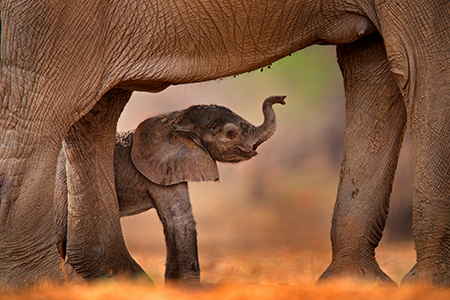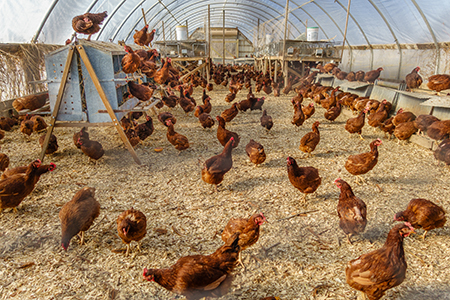
Inside This Issue:
- Appreciate the Snake!
- Can You Really Know What Animals Feel?
- Kennel Chaos (Jersey City Shelter Story)
- Elephants' Famous Cancer Resistance: Always a Price to Pay
Appreciate the Snake!

Northern copperhead: one of only two venomous species of snake in West Virginia.
As we continue to warm up this spring, snakes are waking up from their winter brumation, and with that awakening, more and more human-snake encounters. It is common in reptile or snake identification groups to see a dead snake photo asking for confirmation of species only after the snake has been killed. Out of fear and lack of understanding, a lot of people still err on the side of "The only good snake is a dead snake."
But perhaps a little bit of education can help the ophidiophobes among us. With that in mind, the West Virginia Division of Natural Resources (WVDNR) wants residents to understand the critical role snakes play in our ecosystems. Out of the 23 species of snakes that call West Virginia home, only 2 are venomous. The majority of snakes are totally harmless to people. And the 2 venomous species – the Northern Copperhead and Timber Rattlesnake – are fantastic when it comes to pest (rodent) control!
WVDNR’s new website, Snakes Alive! has compiled a list of facts vs myths - something snakes would be grateful for everyone to remember before they meet their untimely demise. So as we humans venture out into the Great Outdoors to soak up the sun, keep in mind that snakes are out doing the same thing. If you see one, back away slowly and let them enjoy the nice weather, too!
Why snakes are the most ‘misunderstood’ animals in West Virginia
Resources
★ (WVDNR) Snakes Alive!
★ Why are we afraid of snakes?
Can You Really Know What Animals Feel?
A fascinating New York Times Magazine piece explains the intersection of science and philosophy behind animal welfare, describes the Animal Welfare Assessment Contest, and has readers ask themselves if they really know what animals are feeling. As you might imagine, the comments section is predictable, but quite entertaining.
Of course, we know a fair bit about how animals behave, about the different things that cause stress for various species, and we have an understanding of (and many vociferous disagreements on) what constitutes proper nutrition, care, and housing for the animals we keep. For people who support the philosophy of animal welfare (separate and at odds with animal rights, as this article points out), this understanding is informed by the concept of the five freedoms (see the link below if you aren’t familiar). Ultimately, animal welfare is about how to better understand and improve the care and conditions of animals, rather than removing animals and the human-animal bond from society altogether.
But no matter how well we painstakingly care for animals, understanding what it is actually like to be one of the animals we observe takes a lot of imagination and at least a little faith. There is a lot we can understand in broad terms, but we fill in many of the gaps and finer points with our own perceptions and biases. By recognizing what we can’t know, it quickly becomes apparent that positive scenarios and outcomes may be very different for individual species as well as types of animals. What works for domesticated pets may be harmful or even deadly for livestock and wildlife!
How Do We Know What Animals Are Really Feeling?
Resources
★ The Five Freedoms
★ How AI is decoding the animal kingdom
Kennel Chaos (Jersey City Shelter Story)
In New Jersey, an experienced shelter manager with a spotless history of working with large and/or “difficult” dogs was hospitalized after an attack by a 40-pound dog. Then, adding insult to injury, she was fired shortly after returning to work. Following the incident and firing, staff morale and shelter protocol – according to off-the-record employees – is in the tank.
The attack is a matter of record and goes to show that no unknown dog is fully predictable, even for someone with decades of experience and a near-supernatural sense of canine disposition. The unfortunate manager suffered three breaks in her arm, endured surgery, IV antibiotics, and was forced to miss a ton of work. As bad as this was, had she not remained calm and forced the dog to release its bite during the attack (rather following the natural instinct to pull away), it could have been far worse.
In the next part of this story, the Jersey City Times details how the returning manager butts heads with a newly installed, clueless shelter director until her zeal for doing the right thing eventually gets her fired. The manager and director get off on the wrong foot, then proceed to argue over policy and operating procedures, over shelter conditions, even over individual issues of animal care. This portrayal would make for a good drama series and undoubtedly rings true for anybody who has ever come out on the wrong side of organizational politics. However, it must be pointed out that we’re only getting one side of a story here. Regardless, one thing that comes up in this article several times is universally true: if workers feel unappreciated and think that the protocols they have to follow are nonsensical, unhealthy, or even dangerous, chaos and understaffing will be chronic problems. For retail and service businesses, chaos and understaffing are business-killers. But for places like shelters, where instability puts animal welfare and public safety in jeopardy, these are problems that affect everybody.
Animal Shelter Morale Sinks After Manager is Bitten, Hospitalized And Fired
Resources
★ County animal shelter manager fired
★ To defend its animal shelter, St. Louis County tried to silence its critics
Elephants' Famous Cancer Resistance: Always a Price to Pay

This calf will no doubt face many challenges in its life, but cancer will not be one of them.
Thanks to the work of researchers like Dr. Joshua Schiffman and the help of organizations like the Hogle Zoo and Ringling Brothers, we know why elephants are so cancer resistant. Despite their long lives and the multitude of cells contained in their giant bodies, it had been observed that these animals almost never get cancer. While this is an interesting factoid in and of itself, unlocking the secrets behind this resistance opens the door for revolutionary treatments for humans and other animals with cancer.
Alas, new research suggests that this super resistance came with a cost: susceptibility to viral and bacterial infections. Elephants don’t get rid of abnormal and damaged cells the way other mammals do, which leaves them vulnerable to serious, often fatal infections from diseases like tuberculosis and herpes. People who work with elephants have long known this is a major threat, and they go to great lengths to protect both captive and wild elephant populations from transmissible diseases (especially herpes). However, these grim findings are also exciting in a way, as our ability to prevent and treat diseases in elephants inevitably improves as our understanding of these wonderful beasts' unusual susceptibility becomes clearer! Given our current fear of pandemics jumping from species to species (see the article on avian flu in the "also" section), this couldn't be more timely.
ScienceAdviser: Elephants almost never get cancer—but this superpower may have cost them
Resources
★ Pervasive loss of regulated necrotic cell death genes in elephants, hyraxes, and sea cows (Paenungualta)
★ The Schiffman Lab
Also in the News...
★ As bird flu spreads in cows, fractured U.S. response has echoes of early covid (Avian Flu; Agriculture; Developing News & Issues)
★ In Philippines’ restive south, conflict is linked to reduced biodiversity (Human Conflict vs. Conservation)
★ Study uncovers neural mechanisms underlying foraging behavior in freely moving animals (Ethology; New Studies)
★ (Video) Environmental advocates work to save Puerto Rican parrot from extinction (Habitat Loss; Climate Change; Conservation; Wildlife Release)
★ Wild Pigs- Not Just a Problem in the South (Feral Hogs of Destiny)
★ Animals get stressed during eclipses. But not for the reason you think (Your LAST Animal Eclipse Article Until 2044)
★ Power Ranking The 14 Wild Animals In Florida That Can Kill You (Deadly Lists; Florida Man; Florida, Man; There Are Definitely More Than 14)
Click here to see what is happening legislatively



